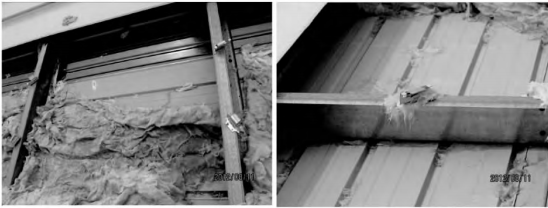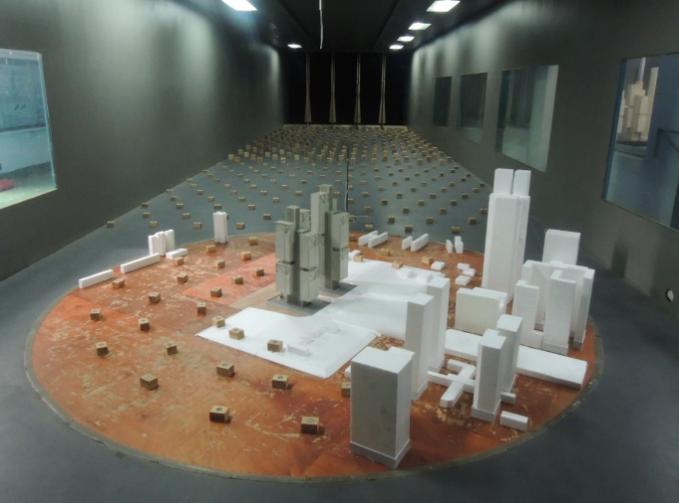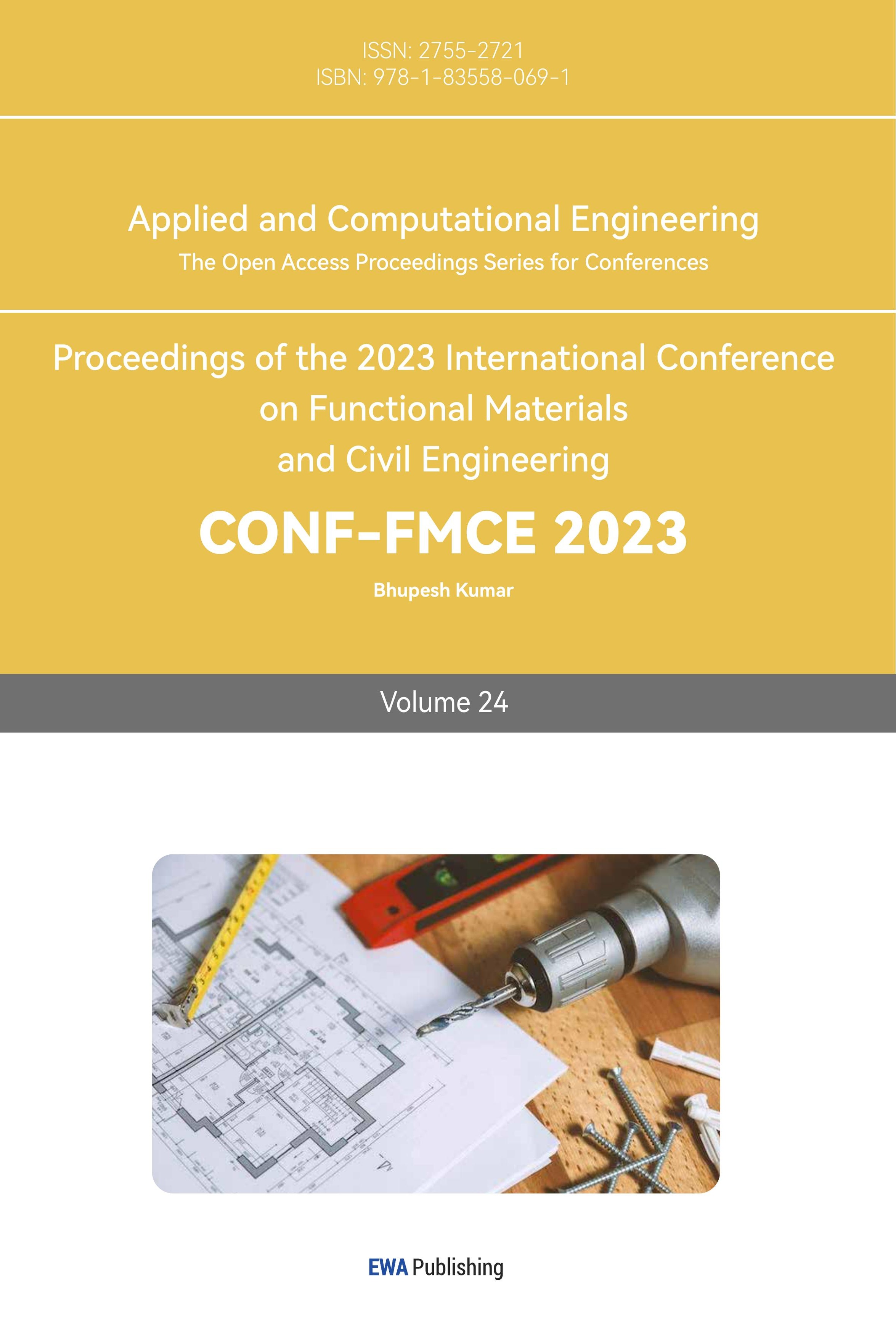1. Introduction
Nowadays, with the continuous development of science and technology and the improvement of building level, there are more and more high-rise building (HRB), which have gradually become the main place for people to live and work. For the safety and comfort of HRB, wind resistance design (WRD) is needed. Especially in some harsh climate areas, buildings need to face the test of strong winds. High winds and their unpredictability pose great challenges to the structure and stability of buildings. And for the high height of the building, the consideration and calculation of wind load need to pay particular attention. Compared with buildings of lower height, HRB not only need to consider the problem of seismic load. As HRB are high sensitivity to wind load, transverse wind load can affect the stability and safety to a certain extent. Therefore, research on WRD and HRB analysis is of great significance to improve the safety and reliability of buildings.
At present, there have been a lot of research results on WRD of HRB. Some scholars and engineers have summed up many experiences and lessons in practice and put forward different design concepts and methods. However, these research results still face many challenges and difficulties, such as wind load calculation, structural dynamic response, structural material selection and so on. Therefore, it is necessary to further study the WRD and analysis of HRB, so as to provide more perfect and reliable solutions for construction projects.
The purpose of this paper is to study the WRD and analysis of HRB and to provide effective wind-proof measures for building projects. Firstly, the characteristics and influence of wind load on HRB are analysed. Then, the current situation of WRD of HRB is analysed and summarized in detail, and the existing problems and deficiencies are put forward. Finally, the solutions and suggestions for wind-resistant design of high-rise structures are put forward.
2. The effect of wind load on HRB
As a force and moment which is on the surface of a building, wind load is quite unpredictable. At the same time, wind load not only acts in the direction perpendicular to the surface of the building, but also produces vertical forces caused by friction in the direction horizontal to the surface of the building. wind load acted on HRB mainly has the following characteristics.
2.1. Irregularity of wind load
As different HRB have different geometric shapes and types of building materials, and wind strength and direction change all the time, which is sometimes impossible to predict. Therefore, wind load acting on the surface of HRB is also irregular and has considerable randomness [1]. This makes it necessary for researchers to consider the experimental error caused by the irregularity when studying wind load on the surface of buildings.
2.2. Instability of wind load
The main cause of wind load is the direct effect of wind power, which is characterized by instability. In the study of wind power and wind load, researchers can only roughly predict the size of wind power, calculate the average value through a period of measurement, and then approximate fit wind power into an extreme value distribution by calculating the variance and standard deviation [2].
2.3. Nonlinear damage
When the wind is stronger, more significant deformation and damage may occur on the surface of the building. However, this damage is usually nonlinear, and the stiffness and strength of the structure of the building will change significantly during the deformation [3]. In 2012, a light steel project in Taiwan was partially damaged by typhoon Haikui. As shown in figure 1, the steel structure was partially lifted by the typhoon and the roof panels were partially damaged.

Figure 1. Project damaged by typhoon Haikui in Taiwan [4].
2.4. Compositional resultant reaction
When wind load acts on the HRB, the internal structure of the HRB will be affected accordingly. Generally, the more complex the structure of the building, the more complex the force and moment under the influence of wind load will be. When studying the internal structure of HRB, it is necessary to consider the interaction between each component comprehensively, and then carry on the force analysis.
2.5. Unsteadiness of wind frequency
Under the action of unsteady wind, the response of the building to wind load is also unsteady. This means that the amplitude of the vibration the structure produces in response to wind load changes over time, as does the frequency of its vibration [5]. On this basis, wind load is highly likely to cause the internal resonance of HRB structures, resulting in structural destruction and serious safety accidents.
3. WRD types and methods
Current HRB have several obvious commonalities. When buildings are high in height, their structures are usually relatively light, less damped and more flexible, etc. Considering the superior frequency of wind load, the building design will be carried out so that the natural vibration frequency of HRB and the superior frequency of wind load acting on its surface is relatively close. This will enable the building structure to withstand wind load with better comfort. At present, in order to reduce the wind load of HRB at high altitude and improve building stability, there are mainly the following methods.
3.1. Section design improvement
Due to the need to meet the principles of beautiful design, it is not possible to modify the section design of the building in a wide range, so it is very important to optimize the building plan to a certain extent. Many experimental data and conclusions prove that after the corner of the building plane is designed, the overall wind strength performance of the structure will be greatly increased. As shown in figure 2, after corner improvement and design of the original rectangular section of the building, certain wind load borne by the building will be reduced by 10%-25% [6]. Such a design not only conforms to the economic principles of structural design, but also does not harm the aesthetics and functionality of the original building. Therefore, the design is a very effective and successful WRD.

Figure 2. WRD for corners of rectangular building sections [6]
3.2. The setting of damping device
In order to increase the comfort of HRB, it is usually designed for the side of the building structure to increase the stiffness of the structure. But such design usually brings high cost and does not conform to the economic principles of design. Therefore, in actual production, the corresponding vibration damping devices are usually set in HRB, such as tuned mass damper AMD, TMD, tuned liquid damper TLD and viscous damper or viscoelastic damper. The above kinds of vibration reduction devices are usually set in the upper or top floors of buildings, and the results are very significant. After EC-TMD was installed on the 125th floor of Shanghai Tower, the wind-induced acceleration of the structure was reduced from 8 gal to 4.3 gal [6].
3.3. Model test
The most widely used model test is the model wind tunnel test. For the specified buildings and structures, in order to test whether they meet the corresponding design standards under the actual wind load, the model wind tunnel test is usually used for simulation testing. The experiment will simulate conditions and parameters similar to the actual wind field to test whether the response of the building to the given wind and wind speed conditions meets the design requirements. As shown in figure 3, the wind tunnel and wind vibration tests were conducted on a building model by South China University of Technology [7].

Figure 3. Wind tunnel and wind vibration test by South China University of Technology [7].
3.4. Wind vibration experiment
In the analysis of WRD, wind vibration experiment is the most necessary. Especially for the situation of HRB, the structure needs to reduce its own vibration amplitude and frequency based on bearing wind load, so as to cater to the good frequency of wind load and prevent structural resonance [8]. At this time, it is necessary to conduct a model wind vibration experiment for a given building and its structure based on theoretical calculation. By simulating the vibration caused by wind load in the actual situation, it is necessary to test whether the wind-earthquake resistance performance of the building is consistent with the theoretical calculation results.
4. Current problems
4.1. The large error of theoretical value
During the analysis of WRD, errors still exist from model tests. Due to the great chance and unpredictability of actual wind speed and direction, the reference significance of the results obtained from model test analysis will be reduced [9]. Although wind tunnel model test and wind vibration test are still the most effective and accurate detection methods. However, they are mainly based on the formula of experience to build the model, there are still errors between the theoretical value and the actual value. Equation (1) is an empirical formula often used to calculate the size of the wind.
\( {F_{w}}={P_{d}}A=\frac{1}{2}ρ{v^{2}}A \) (1)
where \( {F_{w}} \) is wind force (N), A is surface area (m2), Pd is dynamic pressure (Pa), ρ is density of air (kg/m3), and v is wind speed (m/s).
4.2. High cost
During design analysis, due to the need to adopt wind tunnel experiments and other methods to measure and evaluate buildings and structures, inevitably high costs will be generated [10]. In addition, due to the need to consider extreme situations during the design, the strength and stiffness of materials are also high. At the same time, many wind resistance measures currently in production have high maintenance costs and damage costs. As a result, many new methods cannot be really applied. These methods only stay in the theoretical stage, and thus need to be improved.
4.3. Imperfect standard
Current WRD is imperfect and prone to conflict with other standards and principles. The current WRD standards are still in the process of continuous improvement, and according to the experience and actual situation to design standards for development and change, there will inevitably be a lot of unreasonable. And in order to meet the needs of wind-resistant design, aesthetics and partial functionality of the building may be sacrificed.
5. Conclusion
To sum up, wind loads are characterized by irregularity, instability, nonlinearity, combination and instability, which makes the generation and analysis of WRDs very necessary and complicated. At present, in order to achieve WRD and improve the comfort of HRBs, it is usually necessary to improve the plane of HRBsS or install damping devices and dampers. In the analysis of structure and structural components, wind tunnel test and wind vibration test are usually used to analyze the influence of wind on structure by simulating wind load. However, the current WRD still has some problems, such as large error, high cost and imperfect design standards.
The future development and improvement direction of WRD is clearer. Firstly, in order to reduce the error between the theoretical value and the actual value, it is necessary to constantly improve and debug the equipment and innovate the test method. Secondly, the production design cost of windproof structure should be controlled and reduced, and the cost performance of windproof structure should be improved. At the same time, experience should be constantly learned in the experimental and actual production links, and the wind design rules and standards also should be constantly improved.
References
[1]. Thordal M, Bennetsen J, Capra S, and Koss H 2020 Towards a standard CFD setup for wind Load assessment of high-rise buildings: Part 1-Benchmark of the CAARC building J. Wind Eng. Ind. Aerod. 205 p 04283
[2]. Wang J and Cao S 2021 Characteristics of tornado wind loads and examinations of tornado wind load provisions in ASCE 7-16 Eng. Struct. 241 p.112451
[3]. Liu, C, Pan R, Deng X, Xie H, Liu J, and Wang X Random 2022 Vibration and Structural Reliability of Composite Hyperbolic-parabolic Membrane Structures Under Wind Load Thin-Walled Struc. 180 p 109878
[4]. Jin H, Cheng L, Chen M and Fei J 2015 Wind Resistance Design and Construction of Light Steel Building Roof Envelope Steel Cons. 30 p 33
[5]. Wu Y, Wu X, Wei S, Sun Q, and Wang J 2021 Experimental Study of Wind Pressure Fluctuating Characteristics and Wind Load Shape Factor of Long-span Cylinder Roof Structure Struct. Design Tall Special Buildings 30 (10)
[6]. Wang D and Bao L 2019 Development and Prospect of super high-rise building structure Building Struct. 49 p 11
[7]. South China University of Technology Wind Tunnel Laboratory [Shenzhen] DJI Sky City Tower project rigid model wind tunnel test 2017-06-12 https://www2.scut.edu.cn/wind/2017 /0612/c22601a332257/page.htm
[8]. Matsui M, and Tamura Y 2008 Development of a Hybrid Vibration Experiment System for Determining Wind-Induced Responses of Buildings with Tuned Dampers J Wind Eng. Ind. Aerod. 96 (10) pp 2033-41
[9]. Chen Y, Zhang Z, Chen H, and Zheng H. 2020 Robust UC Model Based on Multi-Band Uncertainty Set Considering the Temporal Correlation of Wind/load Prediction Errors IET Gene. Transm. Dis. 14(2) pp 180-90
[10]. Jaimes M, García-Soto, A, Martín del Campo J and Pozos-Estrada A 2020 Probabilistic Risk Assessment on Wind Turbine Towers Subjected to Cyclone-induced Wind Loads Wind Energy 23(3) pp 528-46
Cite this article
Zhao,K. (2023). Analysis and design of high-rise structures for wind resistance. Applied and Computational Engineering,24,38-42.
Data availability
The datasets used and/or analyzed during the current study will be available from the authors upon reasonable request.
Disclaimer/Publisher's Note
The statements, opinions and data contained in all publications are solely those of the individual author(s) and contributor(s) and not of EWA Publishing and/or the editor(s). EWA Publishing and/or the editor(s) disclaim responsibility for any injury to people or property resulting from any ideas, methods, instructions or products referred to in the content.
About volume
Volume title: Proceedings of the 2023 International Conference on Functional Materials and Civil Engineering
© 2024 by the author(s). Licensee EWA Publishing, Oxford, UK. This article is an open access article distributed under the terms and
conditions of the Creative Commons Attribution (CC BY) license. Authors who
publish this series agree to the following terms:
1. Authors retain copyright and grant the series right of first publication with the work simultaneously licensed under a Creative Commons
Attribution License that allows others to share the work with an acknowledgment of the work's authorship and initial publication in this
series.
2. Authors are able to enter into separate, additional contractual arrangements for the non-exclusive distribution of the series's published
version of the work (e.g., post it to an institutional repository or publish it in a book), with an acknowledgment of its initial
publication in this series.
3. Authors are permitted and encouraged to post their work online (e.g., in institutional repositories or on their website) prior to and
during the submission process, as it can lead to productive exchanges, as well as earlier and greater citation of published work (See
Open access policy for details).
References
[1]. Thordal M, Bennetsen J, Capra S, and Koss H 2020 Towards a standard CFD setup for wind Load assessment of high-rise buildings: Part 1-Benchmark of the CAARC building J. Wind Eng. Ind. Aerod. 205 p 04283
[2]. Wang J and Cao S 2021 Characteristics of tornado wind loads and examinations of tornado wind load provisions in ASCE 7-16 Eng. Struct. 241 p.112451
[3]. Liu, C, Pan R, Deng X, Xie H, Liu J, and Wang X Random 2022 Vibration and Structural Reliability of Composite Hyperbolic-parabolic Membrane Structures Under Wind Load Thin-Walled Struc. 180 p 109878
[4]. Jin H, Cheng L, Chen M and Fei J 2015 Wind Resistance Design and Construction of Light Steel Building Roof Envelope Steel Cons. 30 p 33
[5]. Wu Y, Wu X, Wei S, Sun Q, and Wang J 2021 Experimental Study of Wind Pressure Fluctuating Characteristics and Wind Load Shape Factor of Long-span Cylinder Roof Structure Struct. Design Tall Special Buildings 30 (10)
[6]. Wang D and Bao L 2019 Development and Prospect of super high-rise building structure Building Struct. 49 p 11
[7]. South China University of Technology Wind Tunnel Laboratory [Shenzhen] DJI Sky City Tower project rigid model wind tunnel test 2017-06-12 https://www2.scut.edu.cn/wind/2017 /0612/c22601a332257/page.htm
[8]. Matsui M, and Tamura Y 2008 Development of a Hybrid Vibration Experiment System for Determining Wind-Induced Responses of Buildings with Tuned Dampers J Wind Eng. Ind. Aerod. 96 (10) pp 2033-41
[9]. Chen Y, Zhang Z, Chen H, and Zheng H. 2020 Robust UC Model Based on Multi-Band Uncertainty Set Considering the Temporal Correlation of Wind/load Prediction Errors IET Gene. Transm. Dis. 14(2) pp 180-90
[10]. Jaimes M, García-Soto, A, Martín del Campo J and Pozos-Estrada A 2020 Probabilistic Risk Assessment on Wind Turbine Towers Subjected to Cyclone-induced Wind Loads Wind Energy 23(3) pp 528-46









